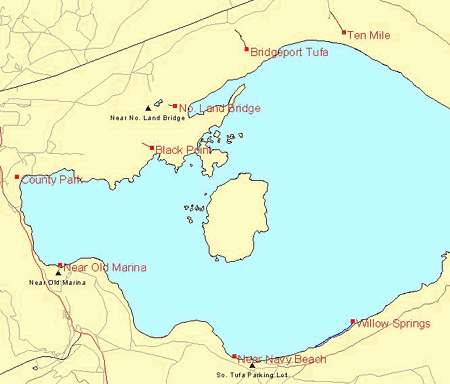Alkali Fly Research at Mono Lake
Research conducted by David "Bug" Herbst, PhD, over the past
25 years has revealed a strong connection between the level of Mono Lake
and the biological productivity of the Mono Lake alkali fly (Ephydra
hians) community in the lake. Higher salinities (at lower lake levels)
required the flies to spend more energy osmoregulating, reducing the
energy they can spend growing and reproducing. The lake level also affects
the availability and quality of the habitat the flies have for
reproduction. Dr. Herbst has shown a dependence of flies for the
availability of "hard" substrate (rock and, to a lesser extent,
submerged vegetation) on which to pupate and gain protection from wave
action.
In order to quantify alkali fly abundance over time as lake level, salinity and substrate availability change and better understand how the flies respond to restoration of the lake as a habitat, Herbst has continued monitoring the alkali fly population as streams resumed flowing into Mono Lake. Beginning in the summer of 1999, and continuing through 2000, Herbst and associate researcher Paul Levine, have been monitoring productivity with the use of artificial substrates. Concrete blocks, similar in texture to tufa, were deployed in various locations around the lake. The sites were chosen to represent the variety of habitats found at Mono Lake (sites shown in red on map).
Artificial substrates were collected throughout the course of the summers of 1999 and 2000 by Paul Levine. Some of the substrates were collected at two week intervals throughout the summer, while others were allowed to remain in the lake for longer periods of time. The following winter was spent measuring the amount of alkali fly colonization on these blocks.
Paul is now examining these samples under a microscope, and scoring the collected larvae and pupae into life stages and size distribution classes. With this information, we will be able to conduct a size frequency analysis. This analysis will be used to develop a more detailed model of the productivity of Mono Lake alkali flies than has been previously possible. This approach will enable year-to-year contrasts of the population and testing of predictions based on experimental evidence and comparative studies. This data will also provide a basis for correlating changes in avian foraging habits at the lake with the availability of alkali fly prey.
